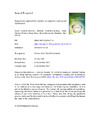Identificador persistente para citar o vincular este elemento:
https://accedacris.ulpgc.es/jspui/handle/10553/75110
| Título: | Deep learning approach for automatic microplastics counting and classification | Autores/as: | Lorenzo Navarro, Javier Castrillón-Santana, Modesto Sánchez-Nielsen, Elena Zarco, Borja Herrera, Alicia Martínez, Ico Gómez, May |
Clasificación UNESCO: | 120317 Informática 330811 Control de la contaminación del agua |
Palabras clave: | Microplastics Image analysis Deep Learning Classification Image analysis Artificial intelligence |
Fecha de publicación: | 2021 | Proyectos: | Estudio de la incorporación de microplásticos marinos a las redes tróficas en Canarias Evaluación del impacto de microplásticos y contaminantes emergentes en las costas de la Macaronesia Evaluación de Los Riesgos Derivados de la Contaminación Marina Por Microplásticos TIN2016-78919-R (Ministerio de Ciencia e Innovación) PID2019-107228RB-I00 (Ministerio de Ciencia e Innovación) |
Publicación seriada: | Science of the Total Environment | Resumen: | The quantification of microplastics is a needed task to monitor its evolution and model its behavior.However, it isa time demanding task traditionally performed using expensive equipment. In this paper, an architecture basedon deep learning networks is presented with the aim of automatically count and classify microplastic particles inthe range of 1–5 mm from pictures taken with a digital camera or a mobile phone with a resolution of 16 millionpixels or higher. The proposed architecture comprises afirst stage, implemented with the U-Net neural network,in charge of making the segmentation of the particles in the image. After the different particles have been iso-lated, a second stage based on the VGG16 neural network classifies them into three types: fragments, pelletsand lines. These threetypeshave been selected for beingthe mostcommon in the range sizeunder consideration.The experimentalevaluation was carried out usingimages taken with two digitalcameras and one mobilephone.The particles used in experiments correspond to samples collected on the beach of Playa del Poris in Tenerife Is-land, Spain, (28° 09′51′′N, 16° 25′54′′W) in August 2018. A Jaccard index value of 0.8 is achieved in the exper-iments of particles segmentation and an accuracy of 98.11% is obtained in the classification of the microplasticparticles. The proposedarchitecture is remarkablefaster than a similar previously published system based on tra-ditional computer vision techniques. | URI: | https://accedacris.ulpgc.es/handle/10553/75110 | ISSN: | 0048-9697 | DOI: | 10.1016/j.scitotenv.2020.142728 | Fuente: | Science of the Total Environment [ISSN 0048-9697], v. 765, 142728 (Abril 2021) |
| Colección: | Artículos |
Citas SCOPUSTM
87
actualizado el 08-jun-2025
Citas de WEB OF SCIENCETM
Citations
71
actualizado el 08-jun-2025
Visitas 5
385
actualizado el 31-may-2025
Descargas
990
actualizado el 31-may-2025
Google ScholarTM
Verifica
Altmetric
Comparte
Exporta metadatos
Los elementos en ULPGC accedaCRIS están protegidos por derechos de autor con todos los derechos reservados, a menos que se indique lo contrario.
